Identifications - Modern History (chapters 33-36): Yes, we are finishing the book!
Third World - EXAMPLE
The "Haves" vs the "Have Nots"
First World countries = developed/industrialized; capitalist, technologically advanced, and high standard of living = examples: US, western Europe, Australia, and Japan
Second World countries = communist nations led by USSR during Cold War era (term not really used any more)
Third World countries - developing countries of Latin America, Africa, and Asia; poor and underdevelped
These definitions are not "black and white" -- the map below show you some of the "grey" area (see the key)

Chapter 33 - Latin America
Augusto Pinochet- Kelly Best
11/25/1915-12/10/2006
Helped Chile with his involvement arrests of communists and suspected communists, as well as union leaders
Heavily resisted opposition (those who spoke out were taken away and became known as “the disappeared”
Created his own constitution in 1980 which gave him sole and total power
Basically, he was able to overthrow Chile with the help of the CIA
Arrested in 1998 for crimes against humanity (escaped trial due to poor health)
"Augusto Pinochet." NNDB. 2009. Notable Names Database. 21 Apr 2009
http://www.nndb.com/people/393/000022327/.
This is Augusto Pinochet
Institutional Revolutionary Party - Sara Marshall
-->AKA- The PRI.
-->The Institutional Revolutionary Party is defined as being a a Mexican political party. It held power in the country of Mexico for 70+ years.
--> PRI was a member of the Socialist International.
--> It was heavily competitive with the Party of the Democratic Revolution within Mexico.
-->Plutarco Elias Calles was the proud founder of the Institutional Revolutionary Party.
--> In Mexico, those that are a part of the PRI are known as "priistas." The group is also known as "el tricolor" within Mexico.
--> The governmental group was found on January 18, 1946.
--> PRI last until about the early 1990s.

This is a photo taken at an Institutional Revolutionary Party rally in 1982.
"Institutional Revolutionary Party (PRI)." U.S. Library of Congress. Web.20 Apr 2009. <http://countrystudies.us/mexico/84.htm>.
Che Guevara - Shelly Franks
- Guevara was born in 1928 in Rosario, Argentina
- His real name was Ernesto Guevara
- Received an M.D. degree from the University of Buenos Aires
- Guevara became a revolutionary because he believed that warfare was the only way to improve social conditions and eliminate poverty
- In 1954 Guevara held a minor post in the Guatemalan government
- After the overthrow he fled to Mexico.
- While he was in Mexico he met Castro and joined his movement to overthrow the government of Cuba
- Guevara served as a physician and military commander in Castro’s guerrilla forces in Cuba during the late 1950’s
- When Castro took control of Cuba in 1959 he appointed Guevara as president of the National Bank of Cuba
- In 1961 he served as minister of industry and directed much of the government’s economic planning until 1965 when he left for Africa where he led a group of Cuban soldiers in support of a revolt in th congo
- He became the leader of a band of guerrillas in Bolivia where he died in 1957
Perez Jr., Louis A. "Guevara, che." The World Book Encloypedia. 2001ed.

Picture of Che Guevara and Fidel Castro
http://simoncross.files.wordpress.com/2008/03/che_guevara_fidel_castro.jpg
Sandinistas and the Nicaraguan Revolution – Rishi Simha
Augusto Sandino was a Nicaraguan revolutionary who was considered a national hero. He led his Nicaraguan army of commoners to a victory over the US marines. In peace talks, he was assassinated, but the Sandinasta National Liberation Front (FSLN) chose to name their political party after him. The FSLN set out to rid the US-backed Nicaraguan dictator, Somoza. Despite initial defeats, with the support of the entire nation and the loss of the US’s support, the FSLN toppled the Somoza rule on July 19, 1979.
Source: "The Sandinista Revolution." ViaNica.com -- Explore Nicaragua online! 20 Apr. 2009 <http://www.vianica.com/go/specials/15-sandinista-revolution-in-nicaragua.html>.

In the city of Managua, the entire Nicaraguan population celebrated the downfall of the Somoza dynasty.
The Contras - Lauren Sink
· The Contras is a label given to the various rebel groups opposing Nicaragua's FSLN (Frente Sandinista de Liberacion Nacional) Sandinista Junta of National Reconstruction following the July 1979 overthrow of Anastasio Somoza Debayle
· included a number of separate groups, with different aims and little ideological unity
· the Nicaraguan Democratic Force (FDN) emerged as by far the largest
· In 1987, virtually all Contra organizations were united, at least nominally, into the Nicaraguan Resistance
· The US CIA supported them from the beginning financially and militarily
· Later, the US Congress wished to distance itself and withdrew all support
· The Contras were active from 1979 to 1990
· Their wars included: Major operations at Siuna, La Bonanza and Rama highway. Numerous Sandinista bases overrun throughout Jinotega, Matagalpa, Zelaya Norte, Zelaya Sur, Chontales, and Rio San Juan provinces.
 The rebellious Contras fought in many battles.
The rebellious Contras fought in many battles.
Wikipedia. Contras. 15 April 2009. 20 April 2009. http://en.wikipedia.org/wiki/Contras
Banana Republics - Lauren Sink
· Banana Republic is a pejorative term for a country that is politically unstable, dependent on limited agriculture, and ruled by a small, self-elected, wealthy, and corrupt clique
· most commonly used for countries in Central America and Africa such as El Salvador, Belize, Grenada, Nicaragua, Honduras, Guatemala, Zimbabwe and South Africa
· In some cases, the government structures were modeled after the colonial Spanish ruling clique, with a small, largely leisure class on the top, and a large, poorly educated and poorly paid working class
· Also typically have large wealth inequities, poor infrastructure, poor schools, a "backward" economy
· As well as, low capital spending, a reliance on foreign capital and money printing, budget deficits, and a weakening currency
· Highly prone to revolutions and coups
 Some Banana Republics were known for the lack of produce like bananas.
Some Banana Republics were known for the lack of produce like bananas.
Wikipedia. Banana Republic. 20 April 2009. 20 April 2009. http://en.wikipedia.org/wiki/Banana_republic
Fidel Castro - (Brianna Kosko)
- Who: A Cuban revolutionary leader who was once prime minister of Cuba.
- What: He was the prime minister of Cuba and then the 23rd president of Cuba.
- When: He was prime minister from February 1959 to December 1976 and then president until February 2008.
- Where: His power and work were both set in Cuba.
- Why: Castro came to power because of the Cuban Revolution which overthrew Fulgencio Batista.
- How it's Important: It's important because he helped transform Cuba into a one-party socialist republic.
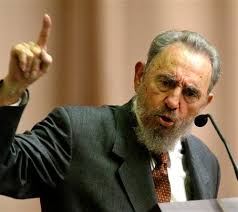 This is a picture of Fidel Castro.
This is a picture of Fidel Castro.
library.thinkquest.org/18355/fidel_castro.html
NAFTA - (Brianna Kosko)
- Who: President Bill Clinton signed NAFTA into law in the United States.
- What: NAFTA is the North American Free Trade Agreement.
- When: NAFTA went into effect on January 1, 1994.
- Where: NAFTA was between Canada, the U.S., and Mexico.
- Why: NAFTA was created to help all three countries benefit from one another.
- How it's Important: It's important because it has been beneficial to business owners and caused slight trade diversion. It also lessened conflicts between the three countries.
 This is the emblem of NAFTA.
This is the emblem of NAFTA.
www.fas.usda.gov/itp/policy/nafta/nafta.html
Chapter 34 - Era of Independence in Africa, the Middle East, and Asia
Decolonization -
Middle Eastern Oil and OPEC - Alexandra Bauer
Middle Eastern Oil and OPEC
· Oil is the main natural resource of the Middle Eastern nations
· OPEC refers to the Organization of Petroleum Exporting Countries
· It is made up of 12 different countries
· In 1949 Venezuela approached Iran and other Middle Easter oil exporting countries in the hopes of forming a league that would promote the welfare of nations rich in oil
· OPEC was officially founded in 1960 in respond to United States President Eisenhower’s decision to enact quotas on Middle Eastern and Venezuelan oil in favor of Canadian and Mexican oil
· The original members of OPEC were Iran, Iraq, Kuwait, Saudi Arabia, and Venezuela
· The 1973 Oil Embargo against the United States was the first official political move of OPEC
· However, in the 1980’s falling oil prices caused OPEC to lose its unity
· Six Middle Eastern nations officially belong to OPEC: Iraq, Iran, Kuwait, The United Arab Emirates, Qatar, and Saudi Arabia
"OPEC." Wikipedia. 20 Apr 2009. Wikipedia Online Encyclopedia. 20 Apr 2009 http://en.wikipedia.org/wiki/Opec.
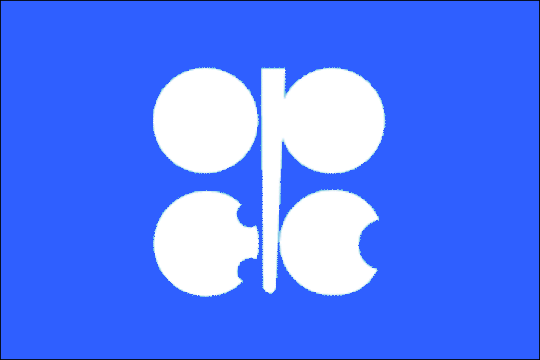 This is a picture of the official logo of OPEC.
This is a picture of the official logo of OPEC.
Gamal Abdel Nasser – Rishi Simha

Nasser was a very popular ruler.
One of the most popular rulers ever, Gamal Abdel Nasser served as the Egyptian President and Prime Minister during his life using a policy called Arab Socialism after being part of a successful coup in 1952. He nationalized banks and the Suez Canal, and he rid the British from Egypt. Nasser advocated Arab unity and lifted many citizens out of poverty through his social policies. Despite resigning after a humiliating defeat in the Six Days War by Israel, his country asked for him back and he returned. In 1970, due to health complications, Nasser’s death shocked the world.
Source: "Gamal Abdel Nasser." LookLex [Travel guides / Encyclopaedia / Language course]. 20 Apr. 2009 <http://looklex.com/e.o/nasser.htm>.
Establishment of Israel - Alexandra Bauer
· The land on which Israel currently resides has long since been considered holy ground for Jews
· After World War II the United Nations was faced with the question of what to do with the large number of displaced Jews who had been forced from their homes during the anti-Semitic movements of pre and WWII
· On November 29, 1947 the United Nations developed the plan to divide the British Mandate of Palestine into two states, one Arab, and one Jewish
· The plan passed and the lines were drawn to create a Jewish state that was predominately Jewish and an Arab state that was predominately Arab
· The Arabs however, extremely prejudice, were unhappy with their land being ripped away to create a Jewish state
· The Arabs had not ratified the United Nations Partition Plan for Palestine
· In 1948 the Arabs declared war on the Jews and the conflict formally ended with the armistice of 1949, but Arab and Jewish hostilities still exists
· The Armistice created the borders of Israel
"Creation of Israel." Wikipedia. Wikipedia Online Encyclopedia. 20 Apr 2009 http://en.wikipedia.org/wiki/Creation_of_israel#1949_Armistice_Agreements.
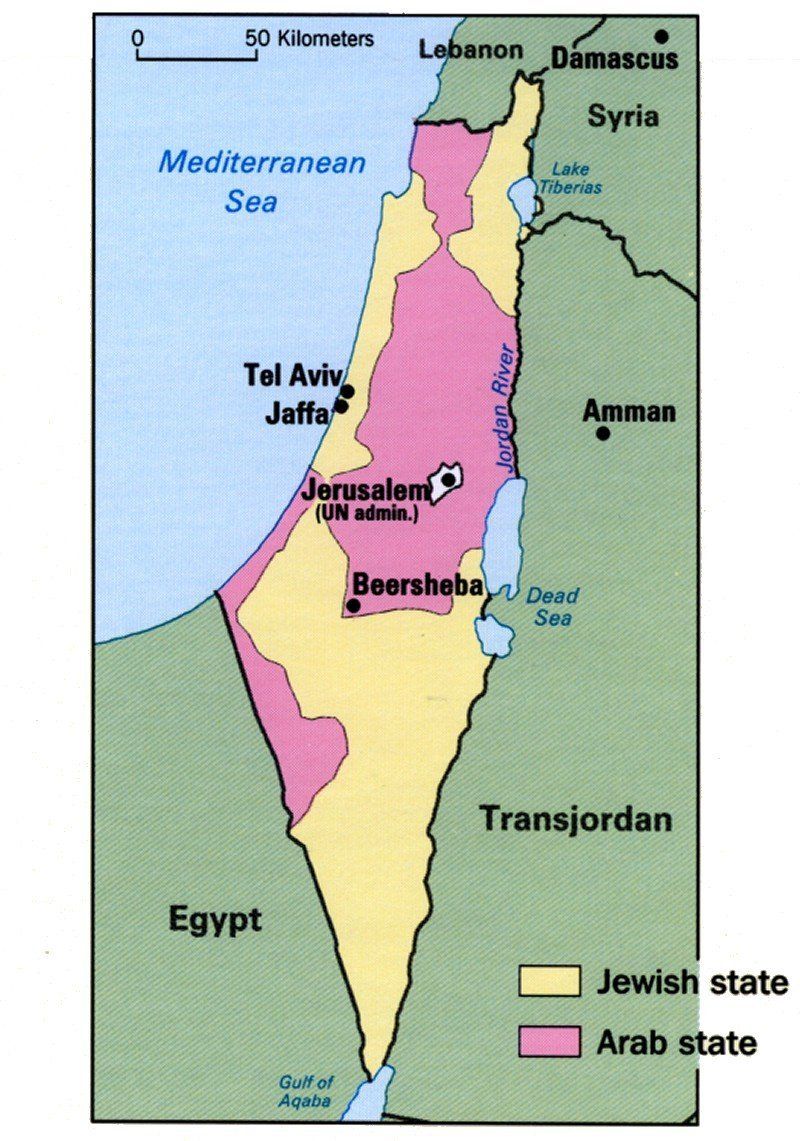 This is a picture of the original map of Israel. It shows the complex division of Arab and Jewish states across Palestine.
This is a picture of the original map of Israel. It shows the complex division of Arab and Jewish states across Palestine.
Arab-Israeli Conflict (maybe brief timeline) -
Yassir Arafat and the PLO - Michael Decker
A group of 20 Palestinian students met in Kuwait and formed the HFT (Fatah). This group is the major Arab Terrorist group in the PLO, which was founded in 1964. Arafat, a Palestinian and Israeli student, soon became leader of the HFT and by consequence the PLO. It is extremely anti-Semitic and anti-Israeli. They created a “phased plan” to eliminate Israel. The PLO refuses to recognize Israel as an entity and takes terrorist measures to subvert peace.
"Yasser Arafat." Wikipedia. 2009. Wikimedia. Web.22 Apr 2009. http://ncvps.blackboard.com/webapps/portal/frameset.jsp?tab_id=_2_1&url=%2fwebapps%2fblackboard%2fexecute%2flauncher%3ftype%3dCourse%26id%3d_4490_1%26url%3d.
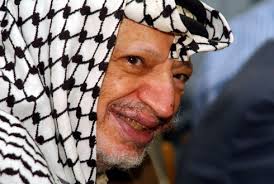
Yassir Arafat is the leader of the terrorist group the PLO.
Menachem Begin, Anwar Sadat, and the Camp David Accords -
The Intifada- Matt Myers
· An uprising of the Palestinians against Israeli rule.
o Thought to have been caused by the Palestinian frustration to the Israeli gains in the 6 days war.
· Started in the Jabalia Refugee Camp and quickly spread to the surrounding areas.
· The movement was mercilessly crushed by the Israelis.
o The uprising gained worldwide media attention.
§ The world was shocked by photos of Palestinians throwing rocks at approaching Israeli tanks.
· The casualties were:
o 1,300 Palestinians (1,000 were additionally killed as “collaborators”)
o 600 Israelis

Pictures such as these were a popular media depiction of the Intifada. They turned public opinion against the Israeli forces, portraying them as ruthless inhibitors of freedom.
Sources:
"First Intifada." Wikipedia. 2009. Web.22 Apr 2009. <http://en.wikipedia.org/wiki/First_Intifada>.
Iranian Revolution and Ayatollah Khomeini (Shampa Panda)
-Took place in 1979
-converted Iran from a monarchy under Shah Mohammed reza Pahlavi to an Islamic theocracy under Ayatollah Khomeini
-Iran voted under national referendum to become a theocracy, possibly in backlash to the increasing opening up to the West under the Shah's regime
-Ayatollah Khomeini was voted the Supreme Leader, with all-encompassing religious and political powers
-Iran is now governed under strict sharia (Islamic) law

A picture of the Ayotollah Khomeini held up my crowds in Tehran, Iran's capital protesting the Shah's regime.
"Iranian revolution." Wikipedia. Wikipedia. 15 Apr 2009 <http://en.wikipedia.org/wiki/Iranian_Revolution>.
Saddam Hussein - Sara Marshall
-->Saddam Hussein was the president of Iraq from July 16, 1979 until April 9, 2003.
-->He was born on April 28, 1937 and died on December 30, 2006.
-->He was the leader of the Revolutionary Ba'ath Party, which expressed things such as Arab Socialism.
-->He reigned in power during major events such as the Iraq-Iran War (1980-1988) and the Persian Gulf War (1991).
-->He strongly supported the Palestanians.
-->He was the 5th president in Iraq.
-->Saddam Hussein was sentenced to death by hanging on December 30, 2006 for conviction of crimes against humanity.

A photo taken of Saddam Hussein when he gave his Army Day speech in Baghdad. (January 6, 2002)
"Saddam Hussein Biography." 2009. Web.20 Apr 2009. <http://www.who2.com/saddamhussein.html>.
Kwame Nkrumah -
Jomo Kenyatta (Sarah Mann)
- 1894 – born in East Africa
- Member of the Kikuyu ethnic group in Kenya
- Some education
- 1920 – became General Secretary of 1st Kenyan African political organization – active in Nairobi
- 1931 – went to Britain and studied anthropology – wrote a study of the Kikuyu called Facing Mount Kenya
- 1945 – helped organize the Manchester Pan-African Congress
- 1946 – returned to Kenya and became president of the Kenya African Union
- Suspected to have organized the Mau Mau movement (attack of white settlers) – Kentayya strongly denied
- 1953 – charged and convicted of managing Mau Mau and got 7 years in prison
- 1962 – Nationalist party KANU elected him leader while in jail – after release elected to legislative council – negotiated terms leading to Kenya’s independence
- 1963 – became 1st Prime Minister of independent Kenya
- 1964 – became President
- Committed to capitalist development and had good relations with the U.K.
- Absorbed political opposition instead of suppressing it
- Known as “Mzee” meaning “elder”
- 1978 – died and Daniel arap Moi became his successor
 This is a picture of Jomo Kenyatta.
This is a picture of Jomo Kenyatta.
"Jomo Kenyatta." Answers.com. 2009. Answers Corporation. 9 Apr 2009
The Mau Mau Uprising- Matt Myers
· An uprising by the Kenyans against the British rule in Kenya.
o Although the revolt failed militarily, it is thought to have hastened the Kenyan independence from Great Britain.
· The movement started as a result of the British settler’s poor treatment of the natives.
o The KUA, a Kenyan group for increased freedoms, was the structure that supported the rebellion.
· The war was soon won by the British due in part to their obviously superior supplies and training.
o The Kenyan insurgents also didn’t effectively use the supplies they had, and some of the supplies were even stolen by the British.
· The uprising was effectively ended with the capture of the last Mau Mau leader, Dedan Kimathi, on October 21, 1956.
o Although the Kenyan insurgents lost the war, the KUA received practically all of the concessions they requested before the war.
· The war showed that the colony was merely being a drain on the English economy, and the Kenyans were soon given their independence.

This cartoon captures the Mau Mau uprising from a British perspective. They saw the uprising as an evil destined to impede British progress in Kenya.
Sources:
"Mau Mau Uprising." Wikipedia. 2009. Web.22 Apr 2009. <http://en.wikipedia.org/wiki/Mau_Mau_Uprising>.
Patrice Lumumba - Cory Hume
Patrice Lumumba was an African anti-colonial leader and the first legally elected Prime Minister of the Republic of the Congo after he helped to win its independence from Belgium in June 1960. Only ten weeks later, Lumumba's government was overthrown during the Congo Crisis. He was eventually imprisoned and murdered by a gun squad led by Belgian officers.

Here is a photo of Patrice Lumamba. He was an exceptionally ambitious leader that sought freedom of the Congo.
“Patrice Emery Lumumba." Africa Within. 27 Apr. 2009 <http://www.africawithin.com/lumumba/historical_bio.htm>.
Mobutu Sese Seko -
Nelson Mandela and the ANC -
Desmond Tutu - Cory Hume
Desmond Tutu is a South African cleric and activist who rose to worldwide fame during the 1980s as an opponent of apartheid. In 1984, Tutu became the second South African to be awarded the Nobel Peace Prize. Tutu was the first black South African AnglicanArchbishop of Cape Town, South Africa, and primate of the Church of the Province of Southern Africa (now the Anglican Church of Southern Africa). Tutu chaired the Truth and Reconciliation Commission and is currently the chairman of The Elders. Tutu is strongly opinioned in his defense of human rights and uses his high profile to campaign for people not so lucky. Tutu also campaigns to fight AIDS, homophobia, poverty and racism. He received the Nobel Peace Prize in 1984, the Albert Schweitzer Prize for Humanitarianism, and the Gandhi Peace Prize in 2005. Tutu has also written several books of his speeches.

This is a photo of Desmond Tutu. He is one of the most influential clergymen and human rights activists to date.
"Desmond Tutu - Biography." Nobelprize.org. 27 Apr. 2009 http://nobelprize.org/nobel_prizes/peace/laureates/1984/tutu-bio.html.
Idi Amin (Uganda) -
AIDS epidemic in Africa----Daniel SM
Evidence supports that HIV began in Africa, the ten year study completed in 2005 found that a Strain of Simian Immunodeficiency Virus SIV was an ancestor of HIV-1 that causes AIDS in humans. The first transfer of SIV to human is thought to have occurred in the 1930’s. The study concluded that around 2000 people had contracted AIDS in Africa by the 1960’s, with the evidence coming from samples gathered by a malaria research group in 1959. An individual is though to have come to Kinshasa in the 1970’s down the Cameroon River into the Congo with the virus and reaching the city he carried the virus into an urban sexual network allowing the virus to spread quickly becoming the first epidemic. By the 80’s Eastern Africa was in the stage of an epidemic because of the low amount of women and many of whom were sex workers and 85% of these having HIV. Doctors were overflowing with people having the “slim disease,” by the 80’s and the doctors realized the similarity with the US AIDS cases. As the number of infected individuals grew and the immigration from rural to urban increased HIV flourish in South, East, and West Africa, with north Africa having none to very little infection.
 This map gives us a visual idea of how bad the eaids epidemic really is.
This map gives us a visual idea of how bad the eaids epidemic really is.
"Aids in Africa." History of Aids. September 12, 2006. AVERT. 28 Apr 2009 <http://www.avert.org/history-aids-africa.htm>.
Independence of India (and J. Nehru) -
Indira Gandhi -
Sukarno and guided democracy (and Suharto) -
Chapter 35 - Nation-Building in East Asia and the Pacific Rim
Vietnam War (basic, broad overview) -already done last week - thanks Will (other section)!
- The Vietnam War has many different names depending on your location. Some parts of the world refer to the Vietnam War as the Second IndoChina War. However the people in Vietnam call the war the American War.
- The war occurred in Laos and Cambodia from 1955 to 1975.
- The war was between North Vietnam supported by its communist allies and South Vietnam
which was supported by the United States and members of the SEATO.
- The Vietcong, the forces of South Vietnam, fought a largely guerilla warfare tactics style. They also relied mainly on the superior air power.
- The North Vietnam army fought a more conventional war style dedicating many troops to its attacks.
- The reason that the United States entered the war was to continue its plan of containment. THey did not want communist forces to take over South Korea.
- In January 1973 there was a treaty signed however fighting still existed. Eventually in 1975 North Korea captured Saigon and this reunited South and North Korea.
- In the Vietnam war between 3 to 4 million Vietnamese people were killed, 1.5 to 2 million Laotians and Cambodians, and 58,189 United States soldiers.
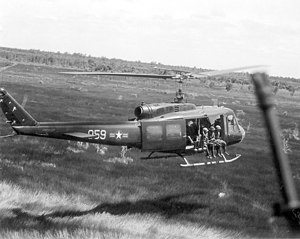 This is a South Vietnamese air force. The South Vietnamese relied heavily on their aerial dominance in this war.
This is a South Vietnamese air force. The South Vietnamese relied heavily on their aerial dominance in this war.
"Vietnam War." Wikipedia. 1 Apr 2009 <http://en.wikipedia.org/wiki/Vietnam_War>.
Korean War (basic, broad overview) - Evan Hokealready done last week - thanks Evan (other section)!
- The Korean War was a conflict between Communist and non-communist forces in Korea from June 25, 1950 to July 27, 1953.
- This conflict took place from June 25, 1950 to July 27, 1953.
- Korea was divided at the 38th parallel into Soviet (North Korean) and U.S. (South Korean) zones of occupation at the end of WWII.
- Rival governments were established in 1948.
- The Republic of Korea was proclaimed in the South and the People's Democratic Republic of Korea in the North.
- The Korean War did prove to be a long and bloody war, though it did not escalate into a world war.
- The greatest burden of the war fell on the shoulders of the United States.

Photos of the Korean War Veterans Memorial.
Photo: "12 Monuments Dedicated to Death and Destruction: From War Memorials to Military Sculptures." 08 MAY 2008 6 Apr 2009.
Info: "Korean War - 1950-53." (1998) 6 Apr 2009.
Khmer Rouge-Estefania Delgado
- Khmer Rouge was Cambodia communist ruling political party which was renamed as Democratic Kampuchea from 1975 to 1979.
- It is remembered mainly for the deaths of an estimated of 1.5 million people, which was 1/5 of the country’s total population.
- The Khmer Rouge period was between 1975 and 1979.
- This period refers to the rule of Pol Pot and the Khmer Rouge political party over Cambodia.
- Cambodians were killed through the combined result of political executions, starvation, and forced labor.
- Its period ended with the invasion of Cambodia by neighbor and former ally Vietnam in the Cambodian-Vietnamese War, in which Cambodia was left under Vietnamese occupation for a decade.

flag of the democratic Kampuchea
"From Sideshow To Genocide:The Khmer Rouge years." 20 Apr. 2009 <http://www.edwebproject.org/sideshow/khmeryears/index.html>.
"Cambodia's brutal Khmer Rouge regime." BBC News. 20 Apr. 2009 <http://news.bbc.co.uk/2/hi/asia-pacific/7002629.stm>.
Postwar Economic Recovery of Japan -
Liberal Democrats (Japan) -
Taiwan and the Kuomintang -Alison Chang
Taiwan
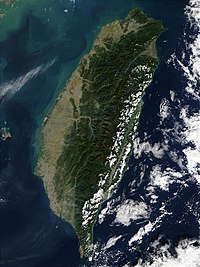

picture of Taiwan Flag of ROC
-An islanf in East Asia off the coast of China, southwest of the main islands if japan but directly west if the end of japan's island, northwest of the Philippines.
-Commonly used to refer to the area under the jurisdiction of the Republic of China (ROC) government.
-Since 1945, Taiwan has been under the administration of the ROC. However, the government of Chian (PRC) considers itself the successor state to the ROC, therefore entitled to all its holdings, including Taiwan, however it has never controlled any of the territory referred to thereas.
Koumintang
 "Blue sky with a white sun." the party emblem of the Koumintang.
"Blue sky with a white sun." the party emblem of the Koumintang.
-The Kuomintang of China(KMT), translated as the Chinese Nationalist Party,
-The founding and the ruling political party of the ROC.
-The headquarters of KMT is located in Taiwan, and KMT is currently the majority party, and the oldest political party in the Republic of China.
In 1949, during the Chinese Civil War, the Koumintang escaped from China and fled the ROC government from Nanking to Taiwan, while continuing to claim sovereignty over China, which the ROC defines to include mainland , Taiwan, outer Mongolia . In China, the victorious Communists established the PRC, claiming to be the sole representative of China including Taiwan and portraying the ROC government on Taiwan as an illegitimate entity.
Some 2 million refugees from China, consisting mainly of soldiers, KMT party members and most importantly the intellectual and business elites fled mainland China and arrived in Taiwan around that time.
http://en.wikipedia.org/wiki/Republic_of_China
http://www.google.com/search?hl=en&rls=com.microsoft%3Aen-us%3AIE-SearchBox&rlz=1I7GGIH&q=taiwan+and+kuomingtang
Great Leap Forward (Sarah Mann)
- 1958-1961
- Attempt by communist Mao Zedong to fix China’s economic problems with industrialization – failed
- Zedong wanted to develop methods of industrialization that would focus on manpower not purchase of machinery (this would put to use China’s large population and eliminate some of the capital needed), wanted to build backyard furnaces in every village (instead of large factories), and decentralized of industries
- Because the plan was put into practice so fast and poorly planned, there were many errors – natural disasters also played a part in the failure of the plan
- Replaced China’s First Five Year Plan of 1953
- Mass starvation brought the Great Leap to an end – millions died
- Based on the Theory of Productive Forces
 This is a poster for steel production. It says, "Take steel as the key link, leap forward in all field’s"
This is a poster for steel production. It says, "Take steel as the key link, leap forward in all field’s"
"Great Leap Forward." Answers.com. 2009. Answers Corporation. 10 Apr 2009
Deng Xiaoping-Crystal Tsang
August 22, 1904(1904-08-22) - February 19, 1997 (aged 92)
Deng Xiaoping was one of the founding members of the Chinese Communist Party. Deng became the CCP’s Secretary General in 1954. Mao dismissed him in 1966, however, because Xiaoping disliked the Great Leap Forward. In 1974, Deng returned to power. After Mao's death, Deng was the leader of China until his death in 1997. From the 1980s until his death, he was widely regarded in the West as being a great leader as he made China much more western and capitalistic. He participated in the Long March. By 1949, after years of close friendship with Mao, he was rapidly promoted through the ranks of the CCP. Deng fell out of favor with Mao when he argued that the Great Leap Forward was a failure because it focused on political correctness and towing the party line more than actually improving the economy, which was why Deng thought it was a disaster. Deng strongly opposed the Cultural Revolution. Deng was blamed for the Tiananmen Square massacre, even though he really wasn’t responsible for it. From 1978 onward, he greatly strengthened the Chinese economy. Overall, his leadership was quite a success.
Deng on the cover of TIME shortly after his return to power (1983).
Source: Spence, Jonathan. "Deng Xiaoping." TIMEasia. 2006. TIME. 17 April 2009. <http://www.time.com/time/asia/2006/heroes/nb_deng.html>
Cultural Revolution (China)-Crystal Tsang
1966-1976. The Cultural Revolution was a political campaign in China created by Mao Zedong to remove his political rivals and make Chinese society revolutionary. In it, millions died or were killed, and it was largely unproductive. Mao launched the Cultural Revolution in 1966 after the failure of his Great Leap Forward. In the Cultural Revolution, Mao attempted to annihilate all moderates, with the assistance of his wife and her friends (the Gang of Four). High school students across the country formed Red Guard brigades, which criticized teachers, school officials, and government leaders for being non-revolutionary. The Cult of Mao blossomed like never before and Mao attempted to implement the destruction of “the four olds”: old ideas, old culture, old customs, and old habits. The Red Guard destroyed everything Western. Despite Deng Xiaoping’s interventions, the Cultural Revolution was largely a failure and ruined the economy, crushed the hopes of the people, and hurt China culturally.
An Idealized Picture of Mao, the Instigator and Symbol of the Chinese Culture Revolution.
Source: "Chinese Revolution." Encyclopedia Britannica. 17 April 2009. <http://www.britannica.com/EBchecked/topic/112760/Chinese-Revolution>
Chapter 36 - Globalization
Modern vs. Postmodern Culture -
World Bank and International Monetary Fund - DANIEL SANMARTIn
After World War II and the Great Depression the World Bank and the IMF were created to help avoid Great Depression like economies and disasters. Being the world’s largest public lender and managing 200 billon it supplies money to member governments with money to help with short term credit crunches. It will lend to countries in debt with policy prescriptions called Structural Adjustment Policies which require the debtor government to open up their economies to foreign corporation, giving them access to the countries workers and environments at a bargain price. This privatizes public utilities and industries, which cut government spending in Health Care and education. This way they can focus on growing export food and not feeding themselves. In countries like Latin America Africa and Asia it only shows to set deeper inequality and destruction. Many protests have spurred on the banks putting the developed world above the interest of the poor majority.
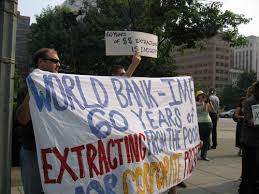
People protesting against the World Bank especailly the poor saying the Bank is taking their money to give to the rich.
"The World Bank’s Latest Identity Change: Climate Change Financier." Earth Beat. September 12, 2006. Earth Beat. 28 Apr 2009 <earthbeatradio.org>.
European Union - already done last week - thank _______!
Energy crunch of the 1970s -
G7 and G8 - Michael Decker
The G8 consist of the 8 most developed countries of the Northern Hemisphere. The EU is also allowed to be represented but may not be the President. It is an informal forum that is used to avert economic hardships. It was founded in 1973, following the oil crisis and what a step to fight economic recessions. The presidency rotates every year and the location of the summit does also. It is a summit used by leaders to talk and think about complex and inter-related issues.
"G8." Wikipedia. 2009. Wikimedia. Web.22 Apr 2009. <http://en.wikipedia.org/wiki/G8>.

The G8 meet annually to discuss matters of Global concern. It includes the 8 industrialized nations of the Northern Hemisphere and, collectively, the EU.
The G7 summit is the regular meeting of head finance ministers of 7 industrialized nations. They attempt to alleviate economic crises and develop strategies to create economic prosperity.

The G7 are finance ministers that meet regularly to discuss matters of economic concern, both global and local (by local, affecting an entire country or region).
"G7." Wikipedia. 2009. Wikimedia. Web.22 Apr 2009. <http://en.wikipedia.org/wiki/G7>.
World Trade Organization (Shampa Panda)
-International organization designed to liberalize international trade, and came into being in 1995
-153 members (95% of the world's trade)
-Headquarters are in Geneva, Switzerland
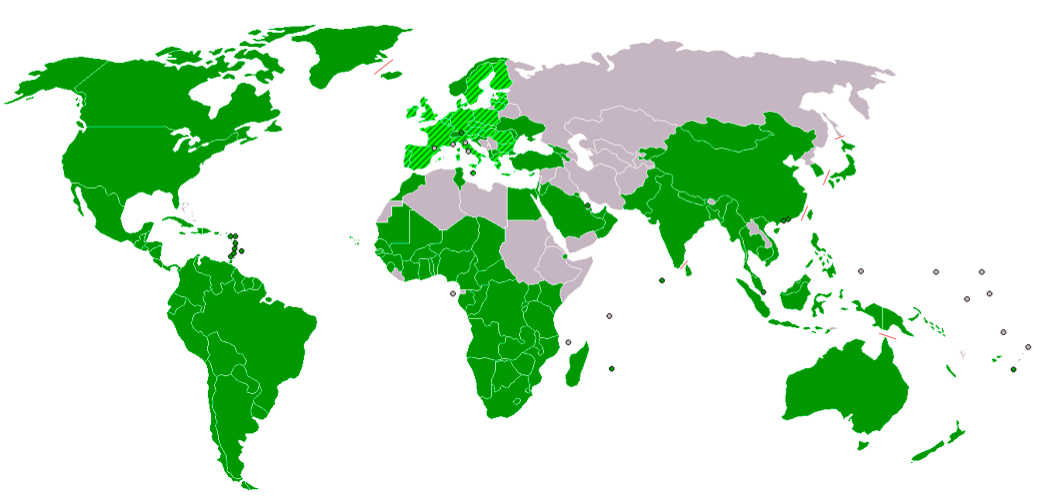
Current members of the World Trade Organization, showcasing the scope of the organization's spread over the world.
"World Trade Organization." Wikipedia. Wikipedia. 15 Apr 2009 <http://en.wikipedia.org/wiki/World_Trade_Organization>.
Economic Globalization -
Consumerism - Kelly Best
Consumerism was a movement for the protection of the consumer and the establishment of the consumer's rights.
Influences: Ralph Nader (aka the "Father of Consumerism")
Teddy Roosevelt (reformed food processing practices after reading the book The Jungle)
Results: Increased consumer security, sanitation, and efficiency.
Several Agencies: (including the )FDA (Food and Drug Administration) and EPA (Environmental Protection Agency)
"Consumerism."Dictionary.com. 26 May 2009 <http://dictionary.reference.com/browse/consumerism>.
"Ralph Nader." Google Images. 26 May 2009 <"Image." Google Images. 26 May 2009

Ralph Nader, the "Father of Consumerism" is responsible for many changes in the production of goods we enjoy today.
![]()
Multinational Corporations -
Environmental Movements -
Terrorism -
Nationalism and ethnic violence -
Mass Media -
Gulf War I (brief overview) -
War on Terror (brief overview) -
Yugoslav Wars - (focus on Bosnia) -
Hutus vs. Tutsis- Estefania Delgado
- Hutus and Tutsis account for nearly all the people of Rwanda and Burundi.
- 90% approximately of Rwandans are Hutu while only 9% are Tutsi.
- 85% approximately of Burundians are Hutu while only 14% are Tutsi.
- Contact between the two groups dates back to the Tutsis' arrival in Hutu territory six centuries ago. But, until the 20th century, they apparently got along
- Tutsis are supposedly taller, thinner, and lighter-skinned, while Hutus are supposedly shorter, thicker, and darker-skinned.

people killed in Rwanda
"A brie" A Brief history 1400-1994." 20 Apr. 2009 <http://www.cnn.com/EVENTS/1996/year.in.review/topten/hutu/history.html>.
Rwanda genocide was in 1994. (Mass of murders penetrated by the Hutu against the Tutsi and vise versa, since 1962, when Belgium granted independence to Rwanda and Burundi.)
Sinn Fein (Ireland) - Alison Chang

the official logo of Sinn Fein
-A political party in Ireland
-The current party, led by Gerry Adams,
-Formed following a split in January 1970 and traces its origins back to the original Sinn Féin party formed in 1905.
-It is a major party of Irish republicanism and its political ideology is left wing
-Sinn Féin is currently the second-largest party in the Northern Ireland Assembly where it has four ministerial posts in the power-sharing Northern Ireland Executive, and the fifth-largest party in Dail Eireann, the lower house of the Oireachtas, the parliament of the republic of Ireland.
Abstract and Surrealist Art -
Existentialism -
Rocketry and Space Exploration -
Biotech, DNA, and genetics -
Information Revolution -
Marshall McLuhan and the global village concept -
Comments (0)
You don't have permission to comment on this page.